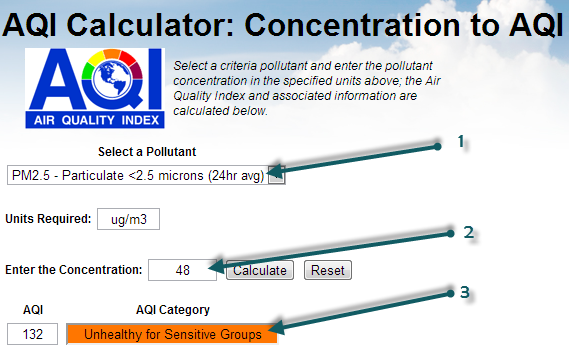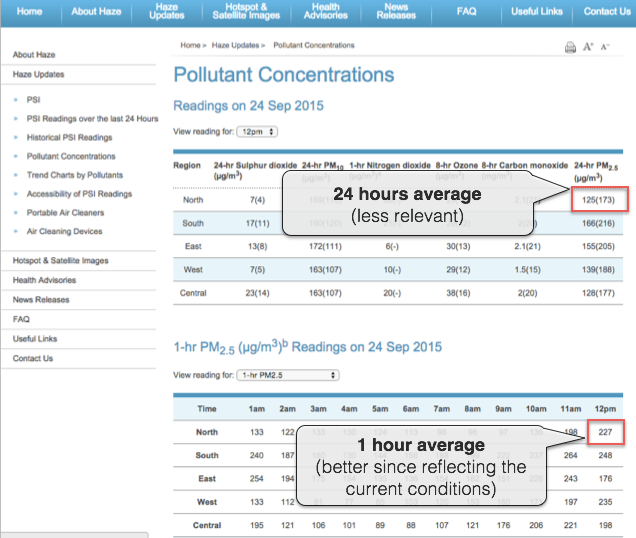In April 2014, the Singapore NEA has updated the PSI calculation to also include PM2.5. http://www.nea.gov.sg/anti-pollution-radiation-protection/air-pollution-control/psi
Với tình trạng Khói sương ở Đông Nam Á gần đây từ Indonesia ảnh hưởng đến Singapore và bây giờ là Malaysia , chúng tôi nhận được nhiều câu hỏi về lý do tại sao có sự khác biệt giữa dữ liệu có thể đọc được từ trang web NEA của Singapore ( nea.gov.sg ) và dự án Chỉ số Chất lượng Không khí Thế giới ở Singapore. trang web .
Ví dụ: đây là những gì có thể đọc ngày hôm nay trên trang web NEA:

Vì một số lý do lịch sử, Singapore đang sử dụng PSI ( Chỉ số tiêu chuẩn ô nhiễm ) để đánh giá Chất lượng không khí. Trong hình ảnh trên, số 1 tương ứng với giá trị PM10 được sử dụng để đánh giá PSI. Giá trị 67(/59) có thể được đọc là 67 μg/m3, tương ứng với PSI là 59. PSI được đánh giá là mức tối đa của PSI riêng lẻ đối với từng chất gây ô nhiễm: PM 10 , SO 2 , NO 2 , O 3 (Ozone) và CO 2 .
PSI(Singapore-North) = max( PSIPM10-based, ... PSIO3-based )= max (59, ..., 77) = 77
Điều thú vị là, trong cùng bảng này, dữ liệu PM2.5 cũng được cung cấp ở cột cuối cùng (xem 3). Dữ liệu này chỉ được cung cấp ở dạng μg/m3 (xem 2) và không có chuyển đổi nào sang PSI (tức là chuyển đổi từ khối lượng PM2.5 sang Chỉ số Ô nhiễm hoặc Chất lượng). Tuy nhiên, sự chuyển đổi này tồn tại và được xác định bởi Cơ quan Bảo vệ Môi trường Hoa Kỳ . Cách dễ nhất để thực hiện chuyển đổi là sử dụng máy tính trực tuyến có sẵn tại airnow.gov :

If you select the PM2.5 (1), then enter the mass concentration of 48 (2), can click on Calculate, you will obtain the AQI of 132 (3). So, based on the PM2.5 AQI conversion, the PSI that is used for Singapore could be extended (let's call it PSI++) to also take into account the PM2.5 information. In which case, the PSI++ would be the maximum of the regular PSI (based on PM10 only) and the PM2.5 AQI:
PSI++ = max( PSI, AQIPM.25 ) = max( 77, 132 ) = 132
This PSI++, that is commonly referred as AQI (or Air Quality Index), is what is being used on the the World Air Quality Index project, for all the cities (provided PM2.5 is available for the city). And this explains why the values are different between the NEA website and the World Air Quality Index project.
Moreover, when doing the convertion, make sure you use the 1-hour reading for the PM2.5 concentration rather than the 24-hours averaged value, as shown on the below image:

http://www.haze.gov.sg/haze-updates/pollutant-concentrations/type/PM25-1Hr
If you want to know more about PM10 vs PM2.5, and especially why PM10 is still used, please check the faq entry about why is PM2.5 often higher than PM10? Is PM10 still a relevant measure?
--
For more information about specific countries or continent, please refer to those articles: Thailand and Malysia - India - China - Hong Kong / Canada (Air Quality Health Index) - South America - Australia - Quebec and Montreal - Singapore - Poland - Indonesia .
For information about the 24 hours averaging used or Ozone and Particulate Matter (PM2.5), please refer to those two articles: Ground Ozone Index - PM2.5 Instant Cast
